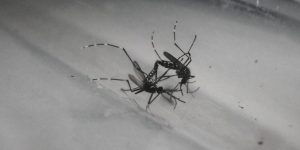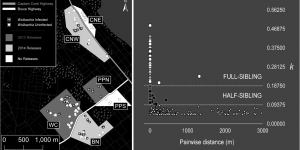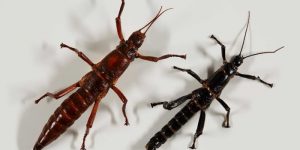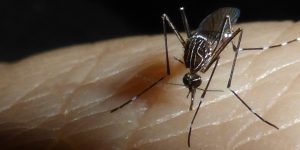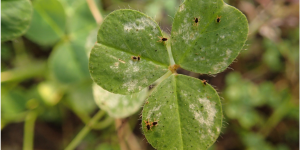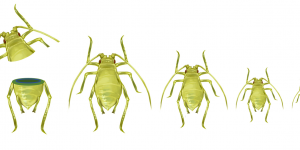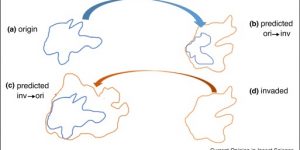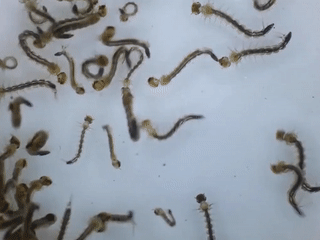pearg
-
Large male mosquitoes unluckier in love
Words and images: Perran Ross Large male mosquitoes may have more trouble than smaller males in finding a partner. In a new study, we find that small female mosquitoes tend to avoid larger males, preferring to mate with smaller ones. In this study, now available as a pre-print on bioRxiv, we performed laboratory experiments to […]blogs.unimelb.edu.au/pearg/2018/05/31/large-male-mosquitoes-unluckier-in-love
-
New publication | Fine-scale landscape genomics helps explain the slow spatial spread of Wolbachia through the Aedes aegypti population in Cairns, Australia
Author summary and figures by Tom Schmidt Wolbachia is a bacterium that suppresses the capacity for arbovirus transmission in the mosquito Aedes aegypti, and can spread spatially through wild mosquito populations following local introductions. Recent introductions in Cairns, Australia have successfully established Wolbachia in the Ae. aegypti population, but the infection has spread more slowly than expected […] -
Insect Armageddon!!? | Ary and others discuss on ABC Radio National Science Friction
Header photo by Museums Victoria, CC BY. Photographer: Rodney Start Original broadcast Sunday 20 May 2018 http://www.abc.net.au/radionational/programs/sciencefriction/insect-armageddon/9775654 -
NEW PROJECT | Buruli ulcer
Words and photo: Jason Axford On 26 April at the Peter Doherty Institute, Federal Minister for Health, Greg Hunt, announced new NHMRC funding to investigate the mysterious and rather horrific disease commonly known as Buruli ulcer (BU) (formerly known as Bairnsdale ulcer). The project is led by Prof. Tim Stinear in the Department of Microbiology […]blogs.unimelb.edu.au/pearg/2018/05/10/new-project-buruli-ulcer
-
NEW PUBLICATION | The influence of host adaptation on crop rotations in managing the redlegged earth mite
Words and photo: Xuan Cheng This research has been published in the Journal of Economic Entomology The redlegged earth mite, Halotydeus destructor (Tucker) (Trombidiformes: Penthaleidae) is a polyphagous economic pest in Australia, attacking a broad range of host plants in broadacre farming systems1. Although applications of pesticides are currently the main method in managing earth […] -
Biology of the babushkas
Words: Samantha Ward As the name suggests, at the Pest & Environmental Adaptation Research Group we are interested in pest species and enjoy investigating novel approaches to sustainably control such organisms. I began my PhD at PEARG in 2016 studying parasitoid wasps; A group of wasps that lay their eggs inside or onto other arthropods. […]blogs.unimelb.edu.au/pearg/2018/05/10/biology-of-the-babushkas
-
Ambiguous literature | kdr triple resistance mutation – Where has it really been found?
Editors note: This article is direct from our internal research diary Words: Nancy M. Endersby-Harshman The purpose of this article is to recommend very careful reading and analysis of the literature relating to sodium channel mutations in Aedes aegypti and equal care in writing about them. I have uncovered some confusion in the mosquito literature […] -
PEARG on the air tonight
Tune in to 3RRR 102.7 FM between 7-8 this evening to hear Ary in discussion about all things insect ecology. If you miss it or live too far from Melbourne to tune in, you can stream the show live at rrr.org.au or after it airs at https://www.rrr.org.au/program/greening-the-apocalypse/ 3RRR is a Melbourne based community radio station, […]blogs.unimelb.edu.au/pearg/2018/05/01/pearg-on-the-air-tonight
-
Rapid evolution in insect pest species
Off the back of a review Ary wrote last year in Current Opinion in Insect Science, a less technical and more digestible summary is now available (sans pay-wall) at Science Trends. A Quote from the Science Trends article to grab your interest: Evolutionary changes often occur when pest species invade new areas where they have […]blogs.unimelb.edu.au/pearg/2018/04/30/rapid-evolution-in-insect-pest-species
-
Collecting fresh mosquitoes | PEARG in the field
Words: Tom Schmidt Photos: Tom Schmidt and Perran Ross At PEARG, we have a great interest in environmental pests and how to deal with them. One of these pests is the mosquito Aedes aegypti, which causes catastrophic damage throughout the world’s tropical zone. Aedes aegypti spreads viruses such as dengue, Zika and chikungunya, and is […]blogs.unimelb.edu.au/pearg/2018/04/30/collecting-fresh-mosquitoes-pearg-in-the-field
Number of posts found: 112
